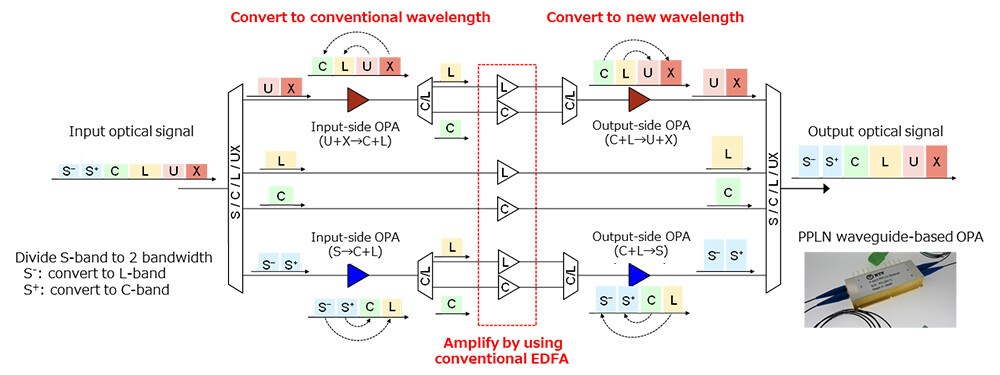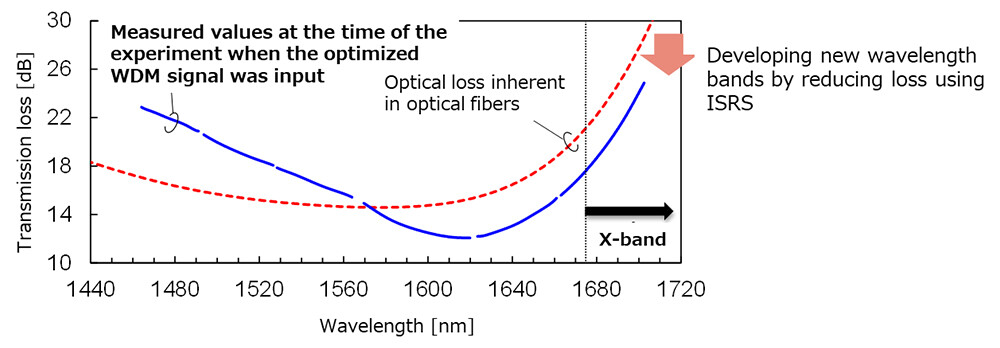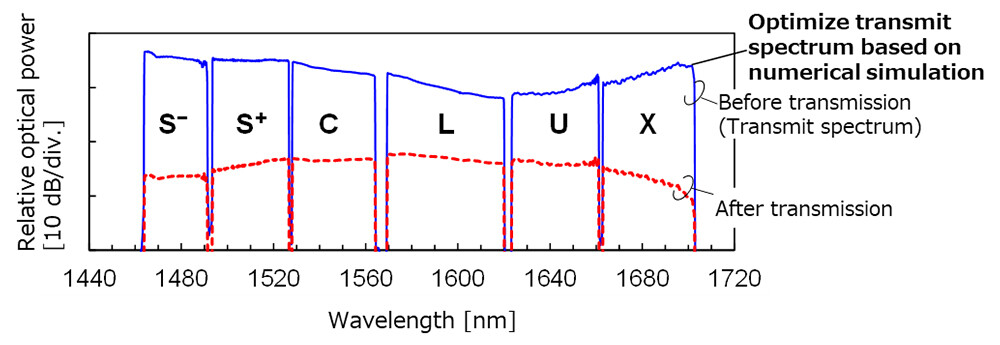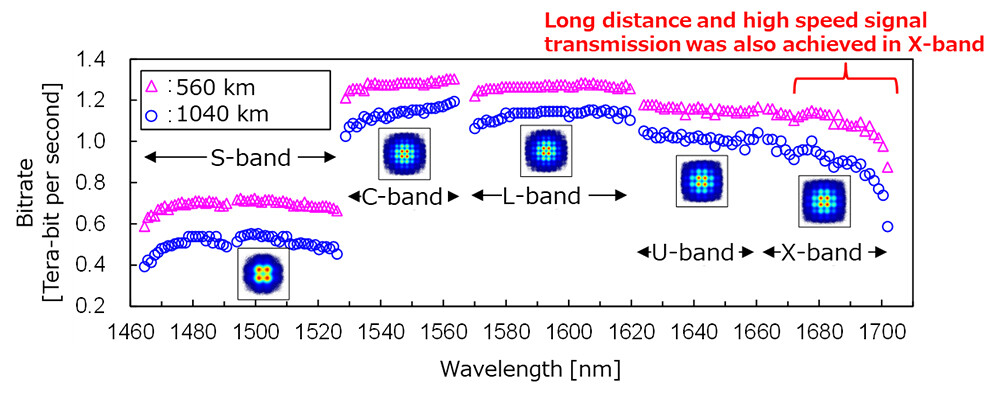Microsoft ends support for Internet Explorer on June 16, 2022.
We recommend using one of the browsers listed below.
- Microsoft Edge(Latest version)
- Mozilla Firefox(Latest version)
- Google Chrome(Latest version)
- Apple Safari(Latest version)
Please contact your browser provider for download and installation instructions.
August 12, 2025
NTT, Inc.
Successful Demonstration of Long-Haul Optical Transmission at 160 Terabits per Second over Distances Exceeding 1,000 km Using a Newly Explored "X Band" Wavelength Range
Toward IOWN and 6G with extended distance and over 10 times higher capacity using the world's widest 27 THz band on existing optical fiber infrastructure
News Highlights:
- Developed a new ultra-wideband optical repeater equipped with a wavelength band converter using PPLN technology. This enabled the use of the previously unavailable long-wavelength region which we newly defined as the X band. As a result, the optical signal bandwidth was expanded to 27 THz, which is more than 6.7 times wider than conventional bands and currently the world's largest.
- Achieved long-haul optical transmission over distances exceeding 1,000 km across the full 27 THz band, including the newly opened X band. This was made possible by applying a transmission design that effectively utilizes nonlinear effects within the optical fiber.
- The results demonstrate the potential for using existing optical fiber to achieve both significantly higher transmission capacity per fiber, exceeding 10 times that of conventional systems, and longer transmission distances exceeding 1,000 km, enough to span the Tokyo-Nagoya-Osaka corridor. This is expected to support the development of core optical networks that can accommodate ever-growing data traffic.
TOKYO - August 12, 2025 - NTT has successfully demonstrated long-haul, high-capacity optical transmission at 160 terabits per second over distances exceeding 1,000 km. This was achieved by exploring a new ultra-long-wavelength region, referred to as the X band, and transmitting ultra-widebandwavelength-division multiplexed (WDM) signals with a total bandwidth of 27 THz [1].
In large-scale optical communication systems, the ability to reach optical signals over distances such as Tokyo-Nagoya-Osaka corridor is essential. Current systems use WDM technology (1), which multiplexes signals across different wavelengths of light. To increase transmission capacity further, expanding the usable wavelength band (2) is crucial.
In this study, a new type of ultra-broadband optical repeater was developed by applying PPLN-based wavelength band conversion technology (3). This allowed the signal bandwidth to be expanded to 27 THz (4), which is more than 6.7 times greater than that of conventional systems.
Furthermore, by leveraging power transfer caused by stimulated Raman scattering, a nonlinear effect within optical fiber, the low-loss transmission window was extended to an ultra-long wavelength region around 1,700 nanometers. This made it possible to transmit ultra-wideband WDM signals over distances exceeding 1,000 km, enabling coverage of long-haul routes such as Tokyo-Nagoya-Osaka corridor.
This achievement is expected to contribute to future All-Photonics Network in IOWN (5) and 6G. By expanding the available wavelength band, it enables both a more than tenfold increase in transmission capacity compared to existing systems (6) and long-distance transmission over distances exceeding 1,000 km.
 Figure 1 Transmission bandwidth of optical signals demonstrated in this study
Figure 1 Transmission bandwidth of optical signals demonstrated in this study
Background
With the rapid expansion of high-quality video streaming services and generative AI, global data traffic continues to increase. Optical fiber transmission systems, which form the foundation of communication networks, are required to continuously expand their capacity to meet this growing demand.
In today's backbone optical fiber systems, digital coherent (7) WDM transmission is widely used. These systems typically utilize a wavelength range of around 4 THz within what are known as the C-band and L-band. These bands correspond to the amplification bandwidth of erbium-doped fiber amplifiers (EDFAs). To further increase capacity, it is essential to develop and utilize new wavelength bands for multiplexing optical signals.
At NTT, research and development have been conducted on wideband optical amplification relay transmission using optical parametric amplifiers (OPAs) (8) based on periodically poled lithium niobate (PPLN) waveguides. As a result, the transmission wavelength range was successfully extended into the U-band, which is the longest wavelength band currently used in optical communications. Combined with the conventional C and L bands, this allowed the use of a total wavelength bandwidth of 14.85 THz. Using this configuration, long-distance and high-capacity optical transmission was demonstrated at 115.3 terabits per second over a distance of 800 km (9).
Despite these advancements, further expansion into longer wavelength regions has been considered extremely difficult. This is mainly due to two factors: the lack of efficient optical amplification relay devices for new wavelength bands and the precipitous increase in transmission loss within conventional optical fibers as the wavelength becomes longer.
Overview of the Achievement
In this demonstration, we developed a new ultra-wideband optical repeater incorporating a PPLN-based wavelength band conversion technology. This allowed us to successfully extend the multiplexable wavelength range for WDM signals into an ultra-long-wavelength region that goes beyond the conventional optical communication bands. This newly explored region is defined as the X band.
By also enabling compatibility with the shorter-wavelength S band, the repeater supports ultra-wideband optical amplification across the S, C, L, U, and X bands. The total available signal bandwidth reached 27 THz, which is more than 6.7 times greater than that of existing transmission systems (6).
In addition, we actively utilized power transfer caused by stimulated Raman scattering, a nonlinear optical effect that occurs within the fiber. This approach effectively reduced the transmission loss in the X band, making WDM signal transmission feasible within this extended wavelength range.
As a result, we successfully demonstrated ultra-high-capacity transmission at 160 terabits per second using existing optical fiber over distances exceeding 1,000 km. This represents the world's highest transmission capacity for this class of transmission and marks a significant expansion in the range where both large-capacity and long-distance transmission can be achieved.
Technical Highlights
● Ultra-wideband optical repeater covering the S to X bands
To achieve both high-capacity and long-distance optical transmission using extended wavelength bands, it is essential to develop optical repeaters that support those bands. Up to now, we have been working on a system configuration that uses PPLN-based optical parametric wavelength band converters to perform all-at-once conversion between conventional bands (such as the C and L bands) and newly explored bands (such as the U band). This allows the use of existing erbium-doped fiber amplifiers (EDFAs) to amplify signals in the new bands.
In this work, we expanded the conversion bandwidth of a previously developed PPLN waveguide designed for conversion between the L and U bands. By adjusting the control parameters, we succeeded in extending the conversion range to cover the X band. As a result, we built a wavelength band converter that enables all-at-once conversion between WDM signals in the U+X bands and those in the C+L bands.
In addition, we developed a new wavelength band converter that bridges the S band and the C+L bands. By combining these converters with EDFAs, we constructed an ultra-wideband optical repeater capable of amplifying WDM signals across the S, C, L, U, and X bands, covering a total bandwidth of 27 THz (Figure 2).
 Figure 2 Configuration of the optical inline repeater covering bands from S to X
Figure 2 Configuration of the optical inline repeater covering bands from S to X
● Extension of optical communication wavelength bands using inter-channel stimulated Raman scattering
Wavelength bands used in optical communication are defined based on the wavelength-dependent transmission loss characteristics of silica-based optical fiber. The longest commonly used band has been the U band, which ranges from 1625 nm to 1675 nm. In general, regions beyond the U band suffer from drastically increasing transmission loss due to the absorption characteristics of the fiber, making them unsuitable for signal transmission.
However, when ultra-wideband WDM signals are transmitted through an optical fiber, Stimulated Raman scattering, one of fiber nonlinear effects, causes optical power to transfer from shorter wavelength channels to longer wavelength channels. This power transfer modifies the effective loss characteristics of the fiber, a phenomenon known as inter-channel stimulated Raman scattering (ISRS).
In this work, we propose the active use of ISRS to transfer optical power from the conventional C and L bands into longer wavelength regions such as the U band and the beyond. This approach effectively reduces the transmission loss in these regions, making them usable for signal transmission.
To enable efficient transmission, it is important to consider nonlinear signal distortions, ISRS effects, and transmission loss during the design of the transmission system. In this demonstration, we transmitted ultra-wideband WDM signals across a total bandwidth of 27 THz. This included the newly extended long-wavelength bands (U and X bands), as well as the S-band, a shorter wavelength band, and the conventional C and L bands.
Since experimentally optimizing the transmission conditions for such ultra-wideband signals is challenging, we used numerical simulations based on the Gaussian noise model (10) to estimate signal quality and determine optimal transmission parameters.
Figure 3 shows the measured wavelength dependence of transmission loss (transmission loss spectrum), comparing the inherent loss of optical fiber with the effective loss during optimized WDM signal transmission.
Due to the ISRS effect, the X band exhibited significantly reduced loss, making it suitable for high-speed optical signal transmission.
 Figure 3 ISRS-induced change in optical fiber loss spectrum (using 80 km standard single-mode fiber)
Figure 3 ISRS-induced change in optical fiber loss spectrum (using 80 km standard single-mode fiber)
Experiment Overview and Results
We constructed a recirculating transmission (11) testbed with a repeater spacing of 80 km, a standard distance in terrestrial fiber-optic networks, and conducted opticallyamplified relay transmission experiments across a 27 THz bandwidth. Standard single-mode fiber, which is widely used in current transmission infrastructure, was employed as the transmission medium. Wavelength division multiplexing was configured with a channel spacing of 150 GHz, with the following allocation of WDM signals: the S band with 54 wavelengths spanning 8.1 THz, the C band with 30 wavelengths spanning 4.5 THz, the L band with 40 wavelengths spanning 6.0 THz, the U band with 28 wavelengths spanning 4.2 THz, and the X band with 28 wavelengths spanning 4.2 THz (Figure 4).
 Figure 4 Optimized transmission spectrum of the optical signals
Figure 4 Optimized transmission spectrum of the optical signals
WDM signals in the S, U, and X bands were generated by converting WDM signals from the conventional C or L bands using wavelength band converters. In total, the system accommodated 180 wavelengths spanning 27.0 THz, achieving a transmission bandwidth that is 1.8 times greater than our previous result, which had a bandwidth of 14.85 THz. We evaluated the signal quality after transmission for each wavelength using 144 Gbaud (12) PCS-QAM signals (13). The result significantly exceeded the previous demonstration (9), which achieved a transmission distance of 800 km and a total transmission capacity of 115.3 terabits per second. In this experiment, we achieved a transmission distance of 1,040 km and a total capacity of 160.2 terabits per second. Furthermore, At a transmission distance of 560 km, which covers the Tokyo-Nagoya section, a total transmission capacity of 189.5 terabits per second was achieved (Figure 5).
Figure 6 shows a comparison of optically-amplified relay transmission experiments using single-mode fiber, where the repeater spacing exceeded 80 km and the total capacity was at least 100 terabits per second, relying solely on lumped amplification. The results obtained in this work represent the world's largest transmission bandwidth (Figure 6(a)) and transmission capacity (Figure 6(b)) for long-distance transmission over existing standard single-mode fiber at distances exceeding 500 km and even 1,000 km. Additionally, we confirmed that per-channel transmission in the X band can achieve data rates on the order of terabits per second, demonstrating the feasibility and effectiveness of utilizing the X band in high-capacity optical transmission systems.
 Figure 5 Bitrates of all 180 wavelength channels
Figure 5 Bitrates of all 180 wavelength channels
 Figure 6 Comparison of long-haul, high-capacity transmission experiments over single-mode fiber with repeater spacing over 80 km (○: NTT, △: other organizations)
Figure 6 Comparison of long-haul, high-capacity transmission experiments over single-mode fiber with repeater spacing over 80 km (○: NTT, △: other organizations)
Future Outlook
The development of a new wavelength band demonstrated in this achievement, along with ultra-wideband amplification and relay transmission technology, is expected to enable significant capacity expansion even in systems using existing installed optical fiber transmission lines. NTT will continue to advance research and development by further integrating its proprietary device technologies with optical transmission technologies aiming to evolve the All-Photonics Network for IOWN and 6G in the 2030s.
Acknowledgments
Part of this research was supported by commissioned research (JPJ012368C04501) and Grants-in-Aid program (JPJ012368G60101) from the National Institute of Information and Communications Technology (NICT), Japan.
[References]
[1]Shimpei Shimizu, Kosuke Kimura, Akira Kawai, Masashi Abe, Shunya Konno, Takushi Kazama, Masanori Nakamura, Fukutaro Hamaoka, Koji Enbutsu, Takahiro Kashiwazaki, Munehiko Nagatani, Hitoshi Wakita, Yuta Shiratori, Hiroshi Yamazaki, Hiroyuki Takahashi, Takeshi Umeki, Takayuki Kobayashi, and Yutaka Miyamoto, "27-THz ISRS-Supported Transmission Over 1040 km in S+C+L+U and Extreme Longer-Wavelength Band," in Optical Fiber Communication Conference (OFC) Postdeadline Papers 2025, paper Th4A.2., 2025.
[Glossary]
(1)Wavelength division multiplexing (WDM)
Wavelength division multiplexing is a technology that increases the transmission capacity per optical fiber by simultaneously transmitting multiple optical signals on different wavelengths.
(2)Optical band names and wavelength ranges
The C and L bands are standard optical communication bands used in long-distance optical transmission due to the low-loss characteristics of silica optical fiber. These bands are internationally standardized by the International Telecommunication Union (ITU-T). The C (conventional) band covers 1530-1565 nm, and the L (long wavelength) band covers 1565-1625 nm. In each band, practical optical amplification and relay are possible. When converted to frequency bandwidth, each band corresponds to approximately 4-5 THz. The 1460-1530 nm range on the short-wavelength side of the C band is referred to as the S (short wavelength) band, and the 1625-1675 nm range on the long-wavelength side of the L band is known as the U (ultralong wavelength) band.
(3)Periodically poled lithium niobate (PPLN)
This is a synthetic crystal in which the spontaneous polarization (the orientation of positive and negative charges in the crystal) of lithium niobate (LiNbO₃), a nonlinear optical material, is periodically reversed. Periodically poled lithium niobate exhibits significantly stronger nonlinear optical effects compared to standard lithium niobate crystals.
(4)As of July 2025, according to NTT.
(5)IOWN
NTT News Release:
Announcement of "NTT Technology Report for Smart World: What's IOWN?"
https://group.ntt/jp/newsrelease/2019/05/09/190509b.html(Japanese)
(6)Existing optical transmission technologies:
NTT Communications (now NTT DOCOMO Business) News Release:
"Construction of a world-class 400 Gbps transmission infrastructure -Dramatically expanding transmission capacity between Tokyo and Osaka-"
https://www.ntt.com/about-us/press-releases/news/article/2019/1209.html(Japanese)
(7)Digital coherent
Digital coherent transmission is an advanced optical transmission method combining digital signal processing and coherent reception. Coherent reception refers to a technique in which the amplitude and phase of the received optical signal are measured by interfering it with a local light source at the receiver. This approach enables high-frequency utilization efficiency through polarization multiplexing and phase modulation, along with high-precision compensation of the optical signal using digital signal processing, significantly improving receiver sensitivity.
(8)Optical parametric amplification (OPA)
This technology amplifies light of a specific wavelength by making light of different wavelengths interact with each other using the nonlinear optical effect generated in a material. Highly nonlinear fibers and lithium niobate are known as nonlinear media.
(9)NTT News Release
"World's first long-haul optical inline-amplified transmission over 100 Tbit/s capacity using ultra long-wavelength band conversion"
https://group.ntt/en/newsrelease/2024/09/03/240903b.html
(10)Gaussian noise model
Noise introduced by optical amplifiers and electrical circuits is typically modeled as Gaussian noise, which is additive (i.e., added to the signal amplitude) and follows a Gaussian (normal) distribution. In contrast, signal distortions caused by nonlinear optical effects in fiber depend on the waveform and are therefore difficult to treat as simple noise. The Gaussian noise model assumes that over long-distance transmission, nonlinear distortions are averaged out due to chromatic dispersion in the optical fiber, allowing these distortions to be approximated as additive Gaussian noise. While signal distortion and noise cannot be strictly added together, the model enables unified treatment of all signal impairments as noise, allowing system design to be based solely on signal-to-noise ratio.
(11)Recirculating loop transmission system
An experimental setup for long-distance optical transmission testing. Optical amplifiers and transmission fibers are connected in a loop, and an optical switch controls the input/output timing of the optical signal. This configuration enables long-distance transmission tests using limited equipment.
(12)Gigabaud (symbol rate unit):
Indicates how many times per second the optical waveform changes. For example, a 144 Gbaud signal changes its optical waveform 144 billion times per second to transmit information.
(13)PCS-QAM signal
PCS (Probabilistic Constellation Shaping) is a technique that optimizes the distribution and placement of signal constellation points based on information theory, thereby reducing the required signal-to-noise ratio for transmission. QAM (Quadrature Amplitude Modulation) is a modulation method that encodes information in both the amplitude and phase of the optical signal. By applying PCS to QAM, signal quality can be optimized according to the transmission conditions. In this study, PCS-64QAM and PCS-16QAM signals were used for evaluation.
About NTT
NTT contributes to a sustainable society through the power of innovation. We are a leading global technology company providing services to consumers and businesses as a mobile operator, infrastructure, networks, applications, and consulting provider. Our offerings include digital business consulting, managed application services, workplace and cloud solutions, data center and edge computing, all supported by our deep global industry expertise. We are over $90B in revenue and 340,000 employees, with $3B in annual R&D investments. Our operations span across 80+ countries and regions, allowing us to serve clients in over 190 of them. We serve over 75% of Fortune Global 100 companies, thousands of other enterprise and government clients and millions of consumers.
Media contact
NTT, Inc.
NTT Science and Core Technology Laboratory Group
Public Relations
Inquiry Form
Information is current as of the date of issue of the individual press release.
Please be advised that information may be outdated after that point.
NTT STORY
WEB media that thinks about the future with NTT










